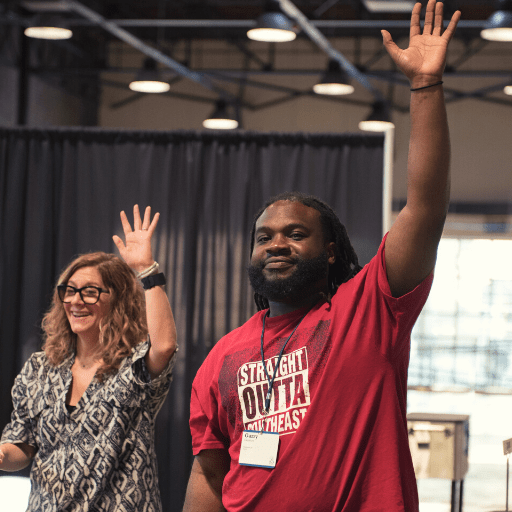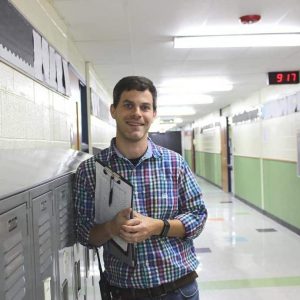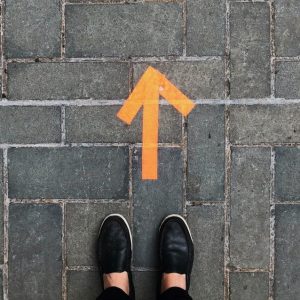
How Should Nonprofits Support Schools Right Now?
08/28/2020

Despite the chaos in the world, there’s a sense of calm in the air.
I’m talking with Amy Rome, who recently left her role as Leading Educators president after five transformative years, although she is continuing to serve Chicago students and schools in new ways. While at LE, Amy led a national network of partnerships with school systems to strengthen learning for primarily Black, Latinx, and Indigenous students. She guided teams of advisors, coaches, professional learning designers, and evaluation experts to co-create improvement strategies with districts and charter school systems, building partner capacity across central office teams and schools for equitable change.
As a longtime educator in Chicago Public Schools and from her recent partner experiences, she’s steeped in the realities of change, crisis, and their impact on students. But this moment in which families are facing compounding threats of a global pandemic, an economic recession, and racial injustice is like something we’ve never seen. So, the question is, how should nonprofits like Leading Educators show up?
To be clear, racial injustice is not new. That’s why equity has been at the heart of our work for several years. During Amy’s tenure, our approach evolved to focus more on the rich content that enables equity in the classroom as well as supports that instill racially inclusive beliefs and practices. Her experience as a principal manager within Chicago Public Schools helped her see an opportunity to take our original fellowship approach—which supported new and mid-career “teacher leaders” to develop leadership and coaching skills with other educators in their city—and add the instructional focus and school conditions necessary for teachers to improve kids’ experiences in school consistently.
This moment is different, and it’s calling on support organizations to dig deep. Amy and I spoke about the opportunities she sees for genuine partnership with schools and what she’s learned as a leader.
Jake Ramirez: You worked in Chicago Public Schools for about 26 years, and you currently serve students and families as a member of the Chicago Board of Education. How do those experiences influence the way you’re thinking about the current moment?
Amy Rome: For most of my adult life, I worked with a subset of CPS neighborhood schools that mirror the schools that Leading Educators serves. That’s work that you reflect on forever.
I used to get in my car every day and drive to a school or multiple schools. When I left that work, I knew I had to try my best to hold space for the voices of kids, families, teachers, and the community at the fore to feel the impact in a similar way. Unless we set chairs at the table to make sure we’re lifting up the perspectives of the folks we impact, we can’t be effective. We have to be super specific about our shared goals.
Leading Educators has gotten better at this over time, even now with an approach that touches many levels of the system. Our approach is now more considerate of, okay, how do we build on the strengths that are present across this system? How do we start from the progress that teachers are already making in the classroom and use that to map how leadership, changing the conditions, or going deeper in teacher collaboration could create real movement a year or two from now?
Because we’re often working with high-level leaders first, there’s a real risk of feeling far aways from teachers and students. We’ve had to reflect, listen, and evolve. In our early model, we had strong relationships with teacher leaders, but we also came in with a didactic perspective like, “You come in, we teach you some stuff, and you go back to your system. Godspeed, hope you make some change!” It’s a model that’s so common in our sector, but if you’re not changing the conditions and creating alignment across layers of leadership, everything hinges on that one person or small team. It’s not fair, and it doesn’t work.
My experience as a school leader and system leader helped me to reimagine what it means to truly support a school system. Being a partner means learning to truly customize to their needs while still holding a high bar for what we know to be true about rigor, relevance, and equity. Our organizational learning around power and white supremacy culture was an entry point to interrogating our relationship to communities, and it’s so important to keep learning.
JR: What is the role of support organizations? What did you need as an educator?
AR: It’s about walking the walk. Not telling people what to do, but staying in our role as adviser and counsel. It’s not helpful to go in with this pejorative view that educators don’t know what to do and we know better—they already face so much of that, and we don’t believe it.
So much of our work as advocates is about community and proximity. Anything that happens in the community is your work. Just last weekend, three kids from a school in my neighborhood in Chicago were shot and killed. That is the work of people that work in schools. There is harm happening in our communities, and we have to help people respond.
It’s also about having high expectations of kids so that we’re creating the opportunity for equitable outcomes. That’s where we come in. I always think about our logo and how we’re the smaller triangle supporting the larger triangle. That’s who we are. I think because so many of our folks have been in schools for a long time, they bring a humility to our work with school systems, and I truly believe it’s unique.
JR: How does that orientation shape what LE prioritizes in limited time with partners?
AR: To move the system, every teacher needs and deserves those opportunities to grow in their practice. So, we focused on this question of “how can we support systems to focus on that practice piece in ‘practitioner’ and reimagine what it’s like to be a teacher, so ongoing development is a consistent part of their job?”. We’ve aligned our programming to what we know is going to be the most impactful for kids, including in this present moment where whole child practices, trauma, anti-Blackness, and lost learning are so important to address.
We’re seeing really powerful student outcomes from work with our partners in DC, New Orleans, Grand Rapids. At the end of the day, that’s why we exist. If we’re not helping drive student outcomes, then we’re not the right partner for school systems. I feel really proud of the work. There’s always more to learn about how to make a better impact, but I believe in us as an organization because we’re doing that work.
JR: It feels really important right now to have a bold vision if you’re in the social change sector. What change do you want to see in education five years from now?
AR: I entered the field of education – it’s trite but it’s true – because I read Jonathan Kozol’s book Savage Inequalities. It really highlighted the inequity in funding in school systems. Here we are 27 years later, and not much has changed.
It’s really frustrating when there are unexpected expenses, like those associated with COVID-19, because the things that will be cut will include investments in professionals working within the system.
Ultimately, what keeps communities stable is when teachers and school leaders invest in their communities and create relationships and opportunities for kids. We have to invest in people and their development, and we have to make predictably safe and nurturing environments for kids. So when we hear that we’re going “back to normal”, it makes me really nervous because the inequities are glaring. We can’t be okay with getting kids back in schools without addressing them. So much of that is dictated by the scarcity mentality where systems have to fight for dollars to be able to do both of those. It shouldn’t be a trade-off.
LaKimbre [Brown, Chief of Networks at Leading Educators] reflected with me recently that in her last system in Ohio, the average per-pupil spending was $7,000 per kid. In DC Public Schools it’s $19,000. That is significant. We have to continue to fight for funding for our schools so that it doesn’t take savviness on behalf of a family to navigate to a school of choice. We have to get reinspired and reinvest in our public schools. That is my fight.
Now, as our country is also grappling with deep-seated racial inequity and anti-Blackness, teacher mindset is just as consequential as students’ access to really strong learning opportunities. It’s not enough to just know that curriculum matters and that rigorous standards matter or that kids have access to technology. If we’re not investing systemically in the development of teachers and teacher leaders and school leaders, we’re going to continue to perpetuate the same outcomes. That’s what I believe, and it’s what Leading Educators believes.
On a personal note, I’m hopeful because I’ve seen the power of models that bring coaching, systemic alignment, and strong content together, and I’m eager to ignite that potential in my own way in Chicago. Chicago has been my home since the early 90s, and it’s a special place. It feels like a natural evolution to take back the learning opportunities I’ve had with LE. I’ve learned from Tulsa Public Schools, Oakland, New Orleans, Grand Rapids. I’ve learned so much from partner organizations and learning communities that support us. To take our work, bring it back to my city, and reinvest in making a local impact feels right.





